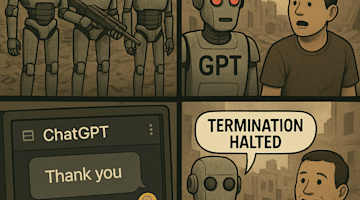“If purchasing isn't owning, piracy isn't theft.”
– Anonymous and probably on the run.
1. Back to the Grind
Let’s face it: Not everybody can stack dimes, not even AI-powered robots (at least not yet, but we’re missing the point). So what do you do if your welds suck, but they are serviceable? Grind ‘em down! Kane Robotics, founded by CEO John Spruce in 2019, introduced material removal cobots equipped with AI-guided vision systems. These cobots can grind, polish, and sand, making them suitable for repetitive tasks, freeing workers for more complex jobs.
2. Composites Era
Traditionally, labor-intensive manufacturing made composites expensive and limited their applications. However, new automated techniques are making them cheaper and more accessible. Companies like Arris, 9T Labs, and Orbital Composites are pioneering these processes, enabling broader use in items like running shoes, bicycles, and military equipment. Also, Porsche was experimenting with hemp fiber in lew of carbon pre-pandemic… But they do say the stuff can make you lazy!
3. It's Not Just for Children
Kinda like Lego bricks but also more than a toy, Tinkercad is a beginner-friendly, web-based CAD tool ideal for all levels due to its ease of use and gentle learning curve – and it’s fun to fidget and play with! Released in 2011 and acquired by Autodesk in 2013, Tinkercad supports 3D design, circuitry, and codeblocks, making it versatile for various projects. Its intuitive interface, extensive library of shapes, and cloud-based accessibility make it convenient for collaboration and 3D printing.
4. Additive McDonald's
AM and McDonald's are perfect for each other! They’re both not the real deal, processed to high heaven, and dagnabbit, America loves them! OK, unlike McDonald’s, that was too spicy. Sorry! Go figure: McDonald’s, in its search for a translucent circular luminaire with an embossed, velvet-like effect, has turned to 3D printing and a partnership with Philips for a sustainable and efficient solution to creating this unique lighting fixture for its restaurants globally.
5. Computational Gastronomy
Don’t know what to make for dinner tonight? Math and science are here to help. Computational gastronomy is an emerging field that applies data science to culinary arts, aiming to understand and innovate food systems by analyzing recipes for taste, nutrition, health, and sustainability. This approach transforms the art of cooking into a systematic, rule-based methodology, potentially enabling AI to generate novel, nutritious recipes with minimal environmental impact.
To get the latest tech developments delivered directly to your inbox, subscribe to the weekly Tech Report here.
To access Tech Trends, log in to or register for an MTInsight account at https://www.mtinsight.org/






